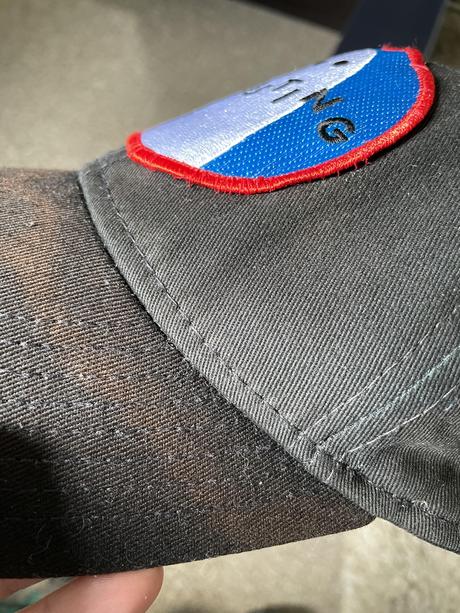Sweat can bleach and discolor clothes over time, particularly in the underarm area, due to the presence of urea which can react with dyes in certain fabrics, causing a yellow discoloration. This is not considered a stain but a permanent discoloration that is difficult to fix.
Sweat contains oils and fats that can leave behind salt residue, which, when exposed to heat, oxidizes and leaves a white powder substance. These stains can become more noticeable over time.
Sweat Discoloration
Sweat can indeed bleach and discolor your clothes over time, especially in the underarm area. This discoloration is not easily fixed and is caused by the ammonia released from sweat reacting with the dyes in certain fabrics. To prevent this, it is recommended to take proper care when laundering sweaty garments.
What Causes Sweat To Discolor Clothes?
Sweat contains a compound called urea, which can break down into ammonia when it reacts with bacteria on the skin. This ammonia can then react with the dyes in certain fabrics, causing a yellow discoloration.
Can Sweat Damage Clothes?
Although sweat is mostly water, it also contains oils and fats. As perspiration evaporates from your garments, it leaves behind salt, which may cause stiffness on your fabric. When the residue encounters heat, it oxidizes, leaving a white powder substance. Over time, these stains can become much more noticeable.
Why Does My Bionic Sweat Bleach My Clothes?
Sometimes even moderate amounts of sweat will bleach all of the dye out of the armpits of shirts and/or sweaters, rendering them ruined after a single wear or two.
Can Your Sweat Really Bleach Your Clothes?
Sweat is naturally colorless, according to the U.S. National Library of Medicine. But the minerals in sweat can react with your deodorant to form stains.
https://www.tiktok.com/api/img/?itemId=7242679351970516270&location=0&aid=1988Credit: www.tiktok.com
Effect On Different Fabrics
When it comes to sweat, many individuals wonder whether it can actually bleach their clothes. It is a valid concern, as nobody wants their favorite garments ruined by unsightly stains or discoloration caused by sweat. While sweat itself is colorless, it contains compounds that can react with certain fabrics, leading to bleaching or yellowing over time. The effect of sweat on different fabrics can vary, depending on their composition and dye. Let’s take a closer look at how sweat can impact black clothes and hats.
Effect On Black Clothes
Black clothes are particularly susceptible to the effects of sweat. When sweat comes into contact with the dyes used to color black fabrics, a chemical reaction can occur, resulting in fading or bleaching of the color. This can be especially noticeable on areas that come into direct contact with sweat, such as underarms or neckline. Over time, repeated exposure to sweat can cause black clothes to lose their vibrant hue and appear dull or lighter in color.
If you want to prolong the lifespan of your black garments and prevent sweat-induced bleaching, consider taking the following precautions:
- Choose fabrics that are less prone to color fading, such as those specifically labeled as sweat-resistant or colorfast.
- Wear undershirts or dress shields to create a barrier between sweat and your black clothes, minimizing direct contact.
- Wash your black clothes in cold water with a gentle detergent designed for dark-colored garments.
- Avoid using bleach or harsh chemicals that can further weaken the fabric and accelerate color fading.
- Hang your black clothes to dry instead of using a dryer, as excessive heat can also contribute to color loss.
Effect On Hats
Hats are commonly worn during physical activities or under direct sunlight, making them susceptible to sweat. The impact of sweat on hats largely depends on the type of material they are made from. Here is how different hat materials may react to sweat:
Hat MaterialEffect of Sweat
CottonMay absorb sweat and develop visible sweat stains. The color of the hat may lighten or become discolored over time.
PolyesterGenerally resistant to color fading and discoloration caused by sweat. However, it may become less breathable and retain odor.
NylonSimilar to polyester, nylon hats are typically resistant to sweat-induced bleaching. They may retain odor more easily.
WoolWool hats can absorb sweat and retain moisture, potentially leading to unpleasant odor. They may require special care and cleaning.
To keep your hats looking fresh and sweat-free, consider these tips:
- Choose hats made from sweat-wicking or moisture-wicking materials, which can help keep sweat away from the fabric’s surface.
- Regularly clean your hats according to the manufacturer’s instructions, especially if they are made from delicate or natural materials.
- Avoid leaving sweaty hats in enclosed spaces for prolonged periods, as this can promote bacterial growth and increase odor.
- Air-dry your hats in a well-ventilated area to prevent moisture accumulation and potential damage from heat.
By understanding the effect of sweat on different fabrics, such as black clothes and hats, you can take proactive steps to protect your garments and extend their lifespan. Being mindful of the materials and care instructions, as well as following proper maintenance practices, can help minimize the detrimental effects of sweat on your beloved wardrobe pieces.
Preventing And Fixing Sweat Discoloration
Sweat is a natural bodily function that helps regulate body temperature, but it can also cause unsightly discoloration on our clothes. The combination of sweat and bacteria can lead to yellow stains or even bleach-like discoloration on clothing, especially in the underarm area. In this section, we will explore effective methods for preventing and fixing sweat discoloration on clothes.
Preventing Sweat Staining On Clothes
Prevention is always better than cure, and when it comes to sweat discoloration, taking proactive steps can help preserve the color and quality of your clothes. Here are some tips to prevent sweat staining on clothes:
- Choose breathable fabrics: Opt for natural fibers like cotton, linen, or silk, as they allow better airflow and help reduce sweating and subsequent discoloration.
- Wear undershirts or sweat guards: Layering a thin undershirt or applying sweat guards to the underarm area can create a barrier between your sweat and the outer garment, preventing direct contact and minimizing staining.
- Use antiperspirants: Applying antiperspirants that contain aluminum chloride can help control excessive sweating, reducing the chances of sweat staining.
How To Fix Sweat Bleached Clothes
If you’ve already noticed sweat discoloration on your clothes, don’t worry! There are some effective methods to fix sweat bleached clothes. Here are a few options you can try:
- Vinegar soak: Mix equal parts white vinegar and water, and soak the affected area in the solution for 30 minutes. Then, wash the garment as usual. Vinegar acts as a natural color-restorer and can help remove sweat discoloration.
- Baking soda paste: Create a paste by mixing baking soda with water until it forms a thick consistency. Apply the paste to the sweat-stained area and let it sit for 30 minutes. Then, rinse off the paste and wash the garment as usual. Baking soda can help neutralize sweat odors and lighten discoloration.
- Hydrogen peroxide soak: Dilute hydrogen peroxide with water in a 1:1 ratio and soak the affected area for 15-30 minutes. Rinse thoroughly and wash the garment afterward. Hydrogen peroxide is known for its bleaching properties and can help lighten sweat stains.
It’s important to note that the success of these methods may vary depending on the fabric and the extent of the discoloration. It’s always a good idea to test these methods on a small, inconspicuous area of the garment before treating the entire stained area.
While sweat discoloration on clothes is a common issue, there are preventive measures you can take to minimize it and effective methods to fix it. By choosing breathable fabrics, layering undershirts or sweat guards, and using antiperspirants, you can reduce the chances of sweat staining. And if you do face sweat bleaching, vinegar soaks, baking soda pastes, or hydrogen peroxide soaks can help restore the color of the affected garments.

Credit: www.reddit.com

Credit: www.livestrong.com
Frequently Asked Questions For Can Sweat Bleach Clothes?
Can Sweat Bleach My Shirt?
Yes, sweat can bleach and discolor your shirt over time, especially in the underarm area. This is not considered a stain but a discoloration that is difficult to fix. Sweat contains urea, which can react with bacteria on the skin and the dyes in certain fabrics, causing yellow discoloration.
How Do You Fix Sweat Bleached Clothes?
To fix sweat bleached clothes, soak them in Oxiclean overnight to remove yellowing. Alternatively, try using a mixture of vinegar and water to treat the discolored areas. Scrub gently and rinse thoroughly before washing as usual. Note that sweat bleaching is not easily fixed, so prevention is key by wearing antiperspirants and avoiding heavy sweating.
What Causes Sweat To Discolor Clothes?
Sweat can discolor clothes due to the compound urea, which can break down into ammonia when it interacts with bacteria on the skin. This ammonia can react with the dyes in certain fabrics, causing a yellow discoloration.
Can Sweat Damage Clothes?
Sweat can bleach and discolor clothes over time. The compound called urea in sweat can react with bacteria on the skin and the dyes in certain fabrics, causing yellow discoloration. Sweat also contains oils and fats, which can leave behind salt residue that may cause stiffness and white powder stains.
Can Sweat Really Bleach Your Clothes?
Yes, sweat can bleach and discolor your clothes over time, especially in areas like the underarms.
Conclusion
Sweat can indeed bleach and discolor clothes over time, particularly in areas like the underarms. This is not considered a stain but rather a discoloration that is difficult to fix. The compound urea present in sweat can react with bacteria on the skin, turning into ammonia and reacting with fabric dyes, causing a yellow discoloration.
Additionally, sweat contains oils and fats that can leave behind salt residue, leading to stiffness and white powder stains when oxidized. To prevent sweat bleaching, it’s important to wash stained clothes promptly and consider using antiperspirants or sweat-wicking fabrics.
